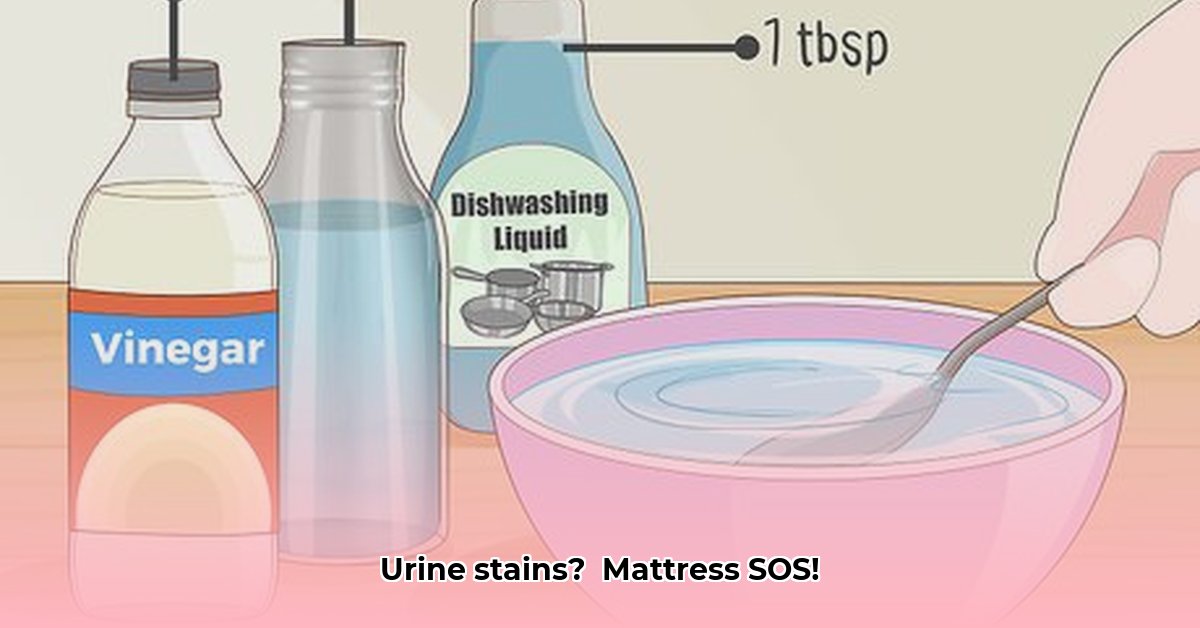Accidents happen. Whether the culprit is a potty-training toddler, a pet, or even yourself, urine stains on a mattress are a common cleaning challenge. This comprehensive guide provides effective, step-by-step solutions for removing urine stains, regardless of their age, origin, or mattress type. We’ll explore various cleaning techniques, delve into specific considerations for different mattress materials, and offer preventative measures to maintain a clean and fresh sleep sanctuary. For other stubborn stains, see our guide on removing blood stains.
Effective Stain Removal: A Targeted Approach
Successfully removing urine stains hinges on a targeted strategy that considers the stain’s freshness and the mattress material.
Fresh Stains: Rapid Response for Optimal Results
Immediate action is paramount when dealing with fresh urine. The quicker you address the spill, the less chance it has to penetrate the mattress fibers and create a lasting stain.
- Blot (Don’t Rub): Gently blot the affected area with a clean, highly absorbent cloth or paper towels. Avoid rubbing, which can spread the stain and push the urine deeper into the mattress. The goal is to lift as much moisture as possible.
- Enzyme Cleaner (Especially for Pets): If the urine is from a pet, using an enzyme cleaner is crucial. These specialized cleaners break down the uric acid crystals in pet urine, effectively neutralizing the odor and preventing re-soiling. Follow the manufacturer’s instructions for application and dwell time. For human urine, an enzyme cleaner is still a strong choice, but not as essential.
- Baking Soda Power: Liberally sprinkle baking soda over the dampened area. Baking soda acts as a natural deodorizer and absorbs residual moisture. Allow it to sit for at least two hours, or even overnight for stubborn stains.
- Vacuum Thoroughly: Once the baking soda has done its work, vacuum it up completely using the upholstery attachment.
Set-In Stains: A Multi-Pronged Attack
Older, dried urine stains require a more persistent approach.
- Pre-Treat with a Vinegar Solution: Mix a solution of equal parts distilled white vinegar and water in a spray bottle. Lightly mist the stained area, ensuring the mattress doesn’t become saturated. Vinegar’s mild acidity helps break down the uric acid crystals.
- Enzyme Cleaner Application: Apply an enzyme cleaner directly to the stain, following the product instructions. Enzyme cleaners are specifically formulated to target and eliminate organic stains and odors.
- Hydrogen Peroxide (Use with Extreme Caution): For exceptionally stubborn stains, a 3% hydrogen peroxide solution can be a last resort. Always test on an inconspicuous area first, as hydrogen peroxide can bleach or discolor some fabrics. If testing is successful, lightly dab the stain with a hydrogen peroxide-soaked cloth and then immediately blot with a clean, damp cloth to rinse.
- Baking Soda Refresh: Sprinkle baking soda over the treated area to absorb any remaining moisture and neutralize lingering odors. Let it sit for several hours, or overnight.
- Vacuum and Air Dry: Vacuum the baking soda thoroughly and allow the mattress to air dry completely. Promote air circulation by opening windows or using a fan. Consider propping the mattress against a wall to facilitate faster drying.
Tailored Cleaning for Different Mattress Types
Mattress composition plays a significant role in determining the appropriate cleaning method.
Memory Foam: Gentle Care is Key
Memory foam is highly absorbent and sensitive to moisture. Blot fresh stains immediately and use an enzyme cleaner. Avoid excessive liquid and never use hydrogen peroxide, which can damage the foam’s structure. Ensure thorough air drying.
Innerspring: Durable and More Forgiving
Innerspring mattresses are generally more resilient. Enzyme cleaners, vinegar solutions, and cautiously applied hydrogen peroxide can be used. Prioritize thorough drying to prevent mold and mildew growth.
Latex: Moderate Resilience
Latex mattresses offer moderate resilience. Enzyme cleaners and vinegar solutions are suitable. Avoid harsh chemicals and ensure complete air drying.
Proactive Prevention: Safeguarding Your Mattress
Preventing stains is always the best strategy.
- Mattress Protectors: Essential Barrier: A high-quality, waterproof mattress protector is an indispensable investment. It acts as a shield against liquids, dust mites, and allergens. Choose a breathable, waterproof protector for optimal comfort and protection.
- Regular Cleaning: Maintaining a Healthy Sleep Environment: Vacuum your mattress regularly (at least monthly) using the upholstery attachment to remove dust mites, dead skin cells, and other debris. Spot clean any spills or stains immediately.
- Pet Discipline and Training: If pets are allowed on the bed, proper house training and consistent reinforcement are crucial. Enzyme cleaners designed specifically for pet urine are essential for addressing accidents.
By following these guidelines and taking a proactive approach, you can effectively conquer urine stains, maintain a hygienic sleep environment, and prolong the life of your mattress.
- Why Call of Duty Not Launching on Steam? Common Technical Reasons - December 24, 2025
- Call of Duty Not Launching Steam? Get Your Game Running Again - December 23, 2025
- Cod Not Launching On Steam? Troubleshoot Common Game Start Issues - December 22, 2025






